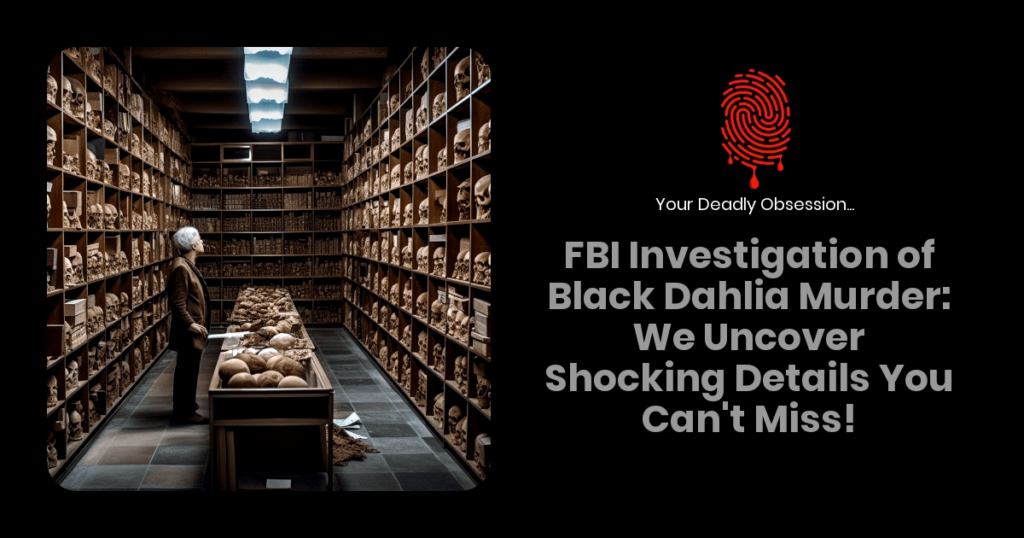Ever since the Black Dahlia murder hit the headlines in 1947, it’s remained one of the most notorious unsolved cases in American history. We’ve all heard the gruesome details of the aspiring actress Elizabeth Short’s mutilated body, and the sensational theories surrounding her killer’s identity. But, what many may not know is just how involved the FBI was in trying to crack this chilling crime.

Back in the day, the FBI was less technologically advanced than it is now, and its resources were stretched thin due to the overwhelming number of high-profile cases at the time. Despite these limitations, the agency threw its full weight behind the investigation. There were countless leads, suspects and dead ends, but to this day, the killer remains unknown. Let’s dive into the FBI’s efforts in this infamous case and see if we can uncover any new perspectives on the Black Dahlia murder.
The Black Dahlia Murder: Origins
Let’s dive right into the dark and twisted world of the Black Dahlia murder. One of the most infamous cold cases in history, this gruesome crime still captures our attention and sends chills down our spines even after all these years. So what exactly happened to the young woman who became known as the Black Dahlia?
On January 15, 1947, Elizabeth Short was found brutally murdered in a vacant lot in Los Angeles. The 22-year-old aspiring actress was left with a gruesome smile carved into her face, her body drained of blood, and cut in half at the waist. It was a truly horrifying scene that left the public flabbergasted and the police baffled.
It quickly became apparent that the case was far from ordinary. The killer had a tormenting touch, evident in the way he abused and mutilated Elizabeth’s body. The murderer sent a package to the press containing her personal belongings, causing an uproar and instilling fear in the community. Despite everything, the Black Dahlia’s murderer was never found, which only intensified the mystery surrounding the case.
Here are some significant facts related to the murder:
- Records show that Elizabeth Short had been in California for less than a year when she met her tragic end.
- The LAPD had more than 150 suspects throughout their investigation, but none led to a conviction.
- Numerous false confessions added to the chaos and complicated the ongoing investigation.
- Among the suspects, some popular theories point to doctors with surgical skills, as the mutilations on Elizabeth’s body were intricate and precise.
- To this day, the Black Dahlia murder remains unsolved and continues to elude those seeking answers.
It’s no wonder that this disturbing case attracts the attention of true crime enthusiasts and budding detectives alike. Despite the passage of time, we remain fixated on the gruesome details, the chilling nature of the evidence, and the seemingly uncrackable mystery that has surrounded this case for decades. The Black Dahlia murder continues to be a source of speculation, intrigue, and inspiration for countless books, documentaries, and films as we all strive to solve one of the most chilling cold cases in American history.
FBI’s Involvement in the Investigation
When it comes to unsolved cases, we can’t help but think about the Black Dahlia murder. First, let’s dive into how the FBI got involved in this ever so mysterious case. In the beginning, the FBI’s involvement was minimal, mainly assisting the Los Angeles Police Department (LAPD) by providing criminal records and fingerprint comparisons. It’s important to note that the case soon became high profile, which led to the FBI taking a more active role.
FBI’s involvement in the case was crucial, as they had access to resources and expertise not available to local law enforcement at that time. Here’s how they contributed to the investigation:
- Analyzing Evidence: The FBI was responsible for examing and testing various pieces of evidence. In doing so, they hoped to uncover any hidden clues that might lead them to the killer.
- Using Advanced Technology: At the time, the FBI had some of the most advanced technology in the world. They used this technology to enhance the investigation, including using sophisticated forensic techniques and tools.
- Consulting with Experts: The expertise of the FBI was unmatched in 1947, and their resources allowed them to consult with some of the best forensic experts in the country. This expert advice proved valuable in guiding the investigation.
During their investigation, the FBI encountered numerous suspects and leads. Some of them included:
- George Hodel: A well-known physician who lived near the crime scene. His own son, an LAPD detective, later accused him of the crime.
- Walter Bayley: A medical doctor who lived only a few blocks from the location where the body was found.
- Norman Chandler: A powerful newspaper publisher at the time, who was rumored to have had an affair with the victim, Elizabeth Short.
| Suspect | Occupation | Connection to Victim |
|---|---|---|
| George Hodel | Physician | Lived near crime scene |
| Walter Bayley | Medical Doctor | Lived near body discovery location |
| Norman Chandler | Newspaper Publisher | Rumored affair with victim |
Despite the FBI’s best efforts, they couldn’t find enough evidence to convict any of the potential suspects. The case remained cold and, up to this day, the Black Dahlia murder still captures the fascination of die-hard fans of cold cases, crime, and mystery.
Suspects and Uncovering Clues
When digging into the various suspects of the Black Dahlia murder, we can’t help but feel that spine-chilling thrill of uncovering long-hidden secrets. Although multiple potential culprits have been suggested over the years, let’s focus on the most noteworthy ones:
- George Hodel: A doctor with a dark past, Hodel was one of the top suspects. We can’t ignore the fact that his son, a former LA homicide detective, believes his father was the murderer. His personal investigation even led to the discovery of a photo resembling the victim in George’s belongings. But still, concrete evidence was lacking.
- Walter Bayley: This surgeon lived close to where Dahlia’s body was found. His surgical skills intrigued investigators who believed the killer would have had some surgical expertise. Bayley’s mental health was also questionable, but no solid facts ever tied him to the crime.
- Leslie Dillon: Known to have interest in discussing the Black Dahlia case, Dillon knew intricate details of the murder. We get goosebumps just thinking about how he even mentioned a “BD” killer in his writings before the murder! Yet, once again, investigators couldn’t find enough proof to convict him.
The pursuit for clues in this case was extensive, to say the least. Key findings included:
- Letters and postcards: The killer seemed to enjoy taunting the LAPD and the media, sending chilling letters and postcards claiming responsibility for Dahlia’s death.
- Victim’s belongings: A week after the murder, Dahlia’s purse and other personal effects showed up in a trash can near the crime scene. The items were cleaned with gasoline to prevent fingerprinting – unsettling, right?
Here’s a simple table of the main suspects and their key traits:
| Suspect | Occupation | Noteworthy Traits |
|---|---|---|
| George Hodel | Doctor | Dark past |
| Walter Bayley | Surgeon | Lived close by |
| Leslie Dillon | Unknown | Knew details |
Despite the chilling details, solid evidence to pin any of these suspects to the crime remains elusive. The pieces of this intricate puzzle just don’t seem to fit together perfectly, leaving us, crime and mystery buffs, continually hunting for the truth in that cold case.
Challenges Faced in the Inquiry
The investigation of the Black Dahlia murder faced numerous obstacles, making it one of the most notorious unsolved cases in the history of the FBI. Let’s dive into the key challenges that we’ve identified from the inquiry:
- Lack of sufficient evidence: Forensic technology was in its infancy back in the 1940s, and investigators were forced to rely on basic methods for collecting and analyzing evidence. Crucial details might have slipped through the cracks due to these limitations.
- A flooded tip line: After the murder gained widespread attention, the police were overwhelmed with leads and tips from the public. Many of these tips were hoaxes or unverified accounts, causing investigators to waste valuable time and resources sifting through irrelevant information.
- Ineffective interrogation techniques: Back then, law enforcement did not have the array of interrogation techniques that are available today. With limited training and resources, it was difficult for investigators to separate fact from fiction during interviews.
There’s a table summarizing some of the challenges:
| Challenges | Effect on the Investigation |
|---|---|
| Lack of sufficient evidence | Hindered efficient analysis |
| A flooded tip line | Wasted time and resources |
| Ineffective interrogation techniques | Hindered extracting useful information |
Additionally, we can’t overlook these factors:
- Multiple suspects: Throughout the course of the investigation, several suspects emerged, making it difficult to pinpoint just one as the likely perpetrator.
- Media sensationalism: The case attracted massive publicity, with newspapers embellishing details and creating wild speculations. This heightened public interest may have tainted the investigation with false leads and incorrect information, further obstructing the inquiry.
- Lack of cooperation from witnesses: Due to the gruesome nature of the crime, several people were hesitant to come forward and share what they knew. This reluctance hampered the investigation immensely as it prevented the police from gathering valuable insights.
- Tunnel vision: In some instances, investigators may have become fixated on particular leads or suspects, preventing them from considering other possibilities. This narrowed perspective may have caused them to overlook clues that could have potentially led to solving the case.
In summary, the FBI investigation of the Black Dahlia murder faced numerous setbacks, from limitations in forensic technology to the flood of unhelpful tips due to intense media coverage. These obstacles have kept the case surrounded by mystery, making it a fascinating one for true crime enthusiasts like us.
Impact of the Case on Pop Culture
The Black Dahlia murder has left a lasting impact on not only American crime history, but also in pop culture. We can see countless references and adaptations of the case throughout various forms of media. In fact, the case became a sensational news story at the time, which drew immense public interest and contributed to its embedding in pop culture. Here are a few notable examples:
- In literature: Several crime fiction novels have been inspired by the Black Dahlia murder, such as James Ellroy’s “The Black Dahlia” published in 1987, and John Gregory Dunne’s “True Confessions” released in 1977. These novels have been praised for their detailed storytelling and captivating plots, shedding light on our fascination with this tragic event.
- In movies and television: Hollywood has also taken an interest in the case, adapting it for the screen. Brian De Palma directed a film adaptation of “The Black Dahlia” in 2006, while a TV movie, “Who is the Black Dahlia?” aired in 1975. The FX TV series, “American Horror Story: Murder House” (2011) also features an episode in which the Black Dahlia character makes an appearance.
- In music: Popular culture has seen various musical references to the case, such as the song “Black Dahlia” by the Los Angeles industrial rock band, Otep. The Black Dahlia murder has served as a thematic base for the band’s lyrics and artistic expressions.
To sum up, the Black Dahlia murder remains a captivating and mysterious event that has transcended boundaries and continues to inspire various artists and creators in pop culture. This notorious unsolved crime fascinates us, pushing us to explore our own morbid curiosity further through books, movies, music, and more.
Has the Black Dahlia murder finally been solved?
The Black Dahlia murder has not been officially solved. Despite numerous theories and suspects over the years, no one has been definitively identified as the killer of Elizabeth Short, also known as the Black Dahlia.
What was the evidence in the Black Dahlia murder?
The evidence in the Black Dahlia murder consisted primarily of the severely mutilated body of Elizabeth Short, discovered in a vacant lot in Los Angeles on January 15, 1947. There was no murder weapon or direct witnesses, and despite numerous interviews and extensive investigation, the case remains unsolved due to a lack of conclusive evidence.
Conclusion: Learning from the Unresolved Mystery
Throughout our exploration of the FBI investigation of the Black Dahlia murder, we’ve learned that cold cases can teach us a lot about investigative techniques and approaches. We can analyze what worked, what didn’t, and apply this knowledge to future cases.
One key takeaway from the investigation is the importance of inter-agency cooperation. Sharing information and resources was essential to making progress in the case, so law enforcement agencies should continue fostering collaboration to benefit their investigations.
Here are a few more lessons we can learn from the Black Dahlia case:
- The significance of local knowledge: Detectives familiar with the case and the crime scene often have valuable insights that help piece together the bigger picture.
- Underneath the sensationalism, there’s still much to uncover: Media attention surrounding high-profile cases can often overshadow important clues and evidence. Investigators must remain focused and diligent to filter out the noise and discover critical leads.
- Murder has no expiration date: It’s essential to never give up on a case, no matter how unlikely that it might be solved. New discoveries, technological advancements, and public interest can potentially shed light on the darkest of mysteries.
The Black Dahlia murder case remains an enigma to this day, but we continue to learn from its journey. From the mistakes made during the investigation and the ever-changing theory landscape, we inch closer to understanding the events surrounding that fateful day. Our fascination with this unresolved mystery reinforces our passion to seek justice for those who cannot speak for themselves.
In the end, we’re inspired to keep searching for answers and doing our part to bring closure to grieving families, with the hope that one day, we can finally discover the truth behind dark mysteries like the Black Dahlia murder.
References:
https://www.fbi.gov/history/famous-cases/black-dahlia
https://en.wikipedia.org/wiki/Black_Dahlia
https://www.theguardian.com/us-news/2016/may/26/black-dahlia-murder-steve-hodel-elizabeth-short

Owner & entrepreneur with a passion for murder mystery! Seriously, who doesn’t love murder mystery?
Chris is a proud member of the American Medical Writer’s Association (AMWA), the International Society for Medical Publication Professionals (ISMPP), the National Association of Science Writers (NASW), the Council of Science Editors, the Author’s Guild, and the Editorial Freelance Association (EFA).

